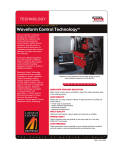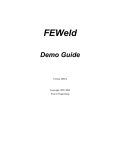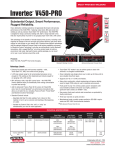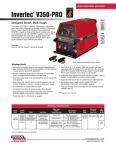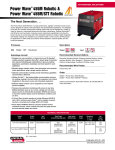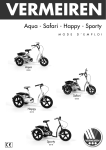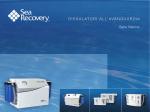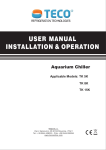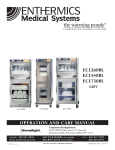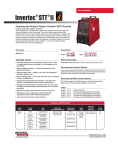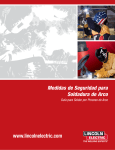Download Lincoln Electric Making Fillet Welds User's Manual
Transcript
APPLICATION W A V E F O R M C O N T R O L T E C H N O L O G Y T M Making Fillet Welds with Power Wave AC/DC 1000™ System Welding Guide Now from Lincoln - the power to increase productivity with Power Wave technology! Lincoln Power Wave technology based upon the new Power Wave AC/DC 1000™ power source provides the opportunity to significantly lower the cost of making fillet welds and at the same time, makes many of the issues that cause weld defects a thing of the past. In some respects, the Power Wave AC/DC 1000™ describes both a new generation of equipment and a new technology for controlled welding. 40% Increase in Travel Speed 5/16” (8mm) Horizontal Fillet Weld 5/32” (4mm) Dia. Electrode 525 Amperes (Both Welds) Now, from a single power source it is possible to choose the very best type of arc characteristic for the particular job at hand. The Power Wave AC/DC 1000™ system allows the choice of the appropriate voltage-current relationship at the mere “flick of a switch”. a d v a n t a g e s CHOICE AT THE “FLICK OF A SWITCH” • Constant current (sometimes referred to as variable voltage). • Constant voltage. • Square Wave AC. UNLIMITED AC OUTPUT TAILORING • Choice of AC frequency (from 10 Hz to 100 Hz). • Wave balance control to allow more or less DC positive component. • Offsetting the AC wave to change the magnitude of the negative or positive component. REDUCTION IN DEFECTS • Virtual elimination of arc-striking problems. • Virtual elimination of arc blow. LOWER COSTS • Documented productivity increases over conventional submerged arc welding. Patented. This product is protected by one or more of the following United States patents: 6,809,292; 6,795,778; 6,700,097; 6,697,701; 6,683,278; 6,660,966; 6,600,134; 6,683,278; 6,596,570; 6,570,130; 6,536,660; 6,489,952; 6,472,634; 6,636,776; 6,486,439; 6,441,342; 6,365,874; 6,291,798; 6,207,929; 6,111,216; 4,927,041; 4,861,965 and other pending U.S. patents. Similar patents are maintained in other countries. T h e f u t u r e o f w e l d © Copyright 2005 The Lincoln Electric Company. All rights reserved. i n g i s h e r e . NX-3.50 5/05 ® W A V E F O R M C O N T R O L T E C H N O L O G Y T M APPLICATION Making Fillet Welds with Power Wave AC/DC 1000™ System 2/10 Welding Guide DC welding has almost always been the preferred choice for producing submerged arc welds. Some of these reasons are: contaminants, organic and/or inorganic contaminants in or on the steel and greater potential for slag entrapment because of the larger and “colder” weld puddle. DC negative has always been the method of choice for welding off-analysis steel or dirty steel where it is desirable to have minimum dilution. But with Power Wave AC/DC 1000™ technology, this is no longer the best option. The Power Wave AC/DC 1000™ provides the capability of easily using the best welding mode for the job at hand. 1. Lowest capital cost for equipment. 2. Greater arc stability than with AC. 3. Virtual elimination of arc striking problems. 4. Power issues (single phase vs. three phase balanced power) While DC negative may offer the highest deposit rate per ampere, it is seldom used for automatic welding that must meet stringent code requirements. This is because DC negative is more prone to magnetic arc interference (arc blow), porosity resulting from Understanding Power Wave AC/DC 1000™ To fully understand the potential for possible productivity gains using the Power Wave AC/DC 1000™ system, understanding the major AC components and what they contribute is helpful. The major components consist of: 1. Square wave (vs. a conventional sine wave) 2. Square wave balance 3. Square wave offset 4. Square wave frequency DC+ 527 Amps Figure 1 shows photographs of two 5/16” (8mm) horizontal fillet welds1. One is made using a good DC+ procedure and one using a square wave 25% balanced, (-)10% offset and 30 Hz. Both are excellent fillets but the square wave procedure is forty percent faster! Note that the amperage used is virtually the same, 520 vs. 527 amperes. 1 AC/DC 520 Amps Figure 1 40% faster travel speeds by using Power Wave AC/DC 1000™ Square Wave procedures over DC+ procedures. These welds comply with the geometry requirements for leg and throat dimensions of all AWS codes. T h e f u t u r e o f w e l d i n g i s h e r e . ® W A V E F O R M C O N T R O L T E C H N O L O G Y T M APPLICATION Making Fillet Welds with Power Wave AC/DC 1000™ System 3/10 Welding Guide SINE WAVE TRANSITION REGION Square Wave vs. Sine Wave SQUARE WAVE TRANSITION REGION Figure 2 shows one cycle of a true 60 Hz sine wave with a square wave superimposed upon it. Note that while the rms2 value and the peak values are the same for both waves, the transition time for peak-to-peak is much shorter for the square wave. The transition period is what has always caused instability with conventional AC welding but with the rapid transition associated with the Power Wave AC/DC 1000™, arc stability is increased. + VOLTS 0 - VOLTS 1 CYCLE 1/60 SECOND Square Wave Balance 60 Hz SINE WAVE vs 60 Hz SQUARE WAVE Figure 2 Square wave balance can allow the arc to act more as a DC negative or DC positive arc, thus increasing deposition rate or increasing penetration. This is always expressed as a percentage of the DC + component. i.e., (25% Balance means that only 25% of the cycle will be positive while 75% of the cycle will be negative, etc.) Figure 3 shows two 3/8” (10mm) flat positioned fillet welds. Both were made at 814 amperes but the square wave AC 25% balance wave is made 17% faster. DC+ Figure 4 graphically shows the significance that square wave balance can and does play. Note that only 25% of the time is the arc positive while 75% of the time it is negative. This flexibility can be used to tailor the arc to achieve best results by increasing deposition, decreasing penetration or decreasing deposition and increasing penetration. AC 25% Balanced Figure 3 Figure 4 2 Rms: root-mean-square value of current or voltage. For example, when someone refers to, “110 volts,” this is actually an rms value as is “30 volts AC”, etc. T h e f u t u r e o f w e l d i n g i s h e r e . ® W A V E F O R M C O N T R O L T E C H N O L O G Y T M APPLICATION Making Fillet Welds with Power Wave AC/DC 1000™ System 4/10 Welding Guide Square Wave Offset Effect Offset is expressed as a percentage between -25% and +25% of the rms2 value that is kept positive or negative. In other words, -25% means the normal positive component of each cycle is held to 25% of the normal rms value and the negative component becomes 75%. In some respects, when offset is adjusted to maximum values, the arc action almost becomes analogous to that of a pulsed arc. Negative values contribute to increasing deposition to levels closely approaching the values obtainable with DC negative welding. See Figure 5. Square Wave - Normal Curve 50% Positive 0 50% Negative 1 CYCLE 1/60 SECOND Square Wave - Current Offset Figure 5 Comparison of offset vs normal balanced wave Figure 6 shows two welds: the same 3/8” (10mm) flat position fillet as Figure 3, but this time made using a setting of 25% balance, (-)10% offset. Note that this results in an additional gain of 12% in travel speed! This is a net gain of 29% over DC+. The increased deposits possible using a combination of wave balance and wave offset may raise the question about root penetration. While at present the major welding codes do not allow sizing a fillet weld based on root penetration, some producers of proprietary products do. Figure 7 shows the depth of penetration as compared to DC+ for a number of settings. This shows a variation of only .05” (1.3mm) in penetration, a variation of nine to ten percent. All of the welds were made when the plate was at room temperature and at 54.25Kj heat input. Mode DC+ Penetration-mm 5.53 Total Amps Total Amps Square Wave - Negative Offset DC+ SW AC with Offset AC 25% Balance (-)10% Offset Figure 6 Square Wave Balanced SW AC 25% Balanced SW AC 25% Balanced (-) 10% Offset SW AC 25% Balanced (-) 20% Offset 4.06 4.06 4.02 4.43 Figure 7 Penetration vs. Various Modes All welds made using 5/32” (4mm) Diameter Electrode 525 Amperes, 31 Volts, 1.25” (31.8mm) ESO 18 ipm (457.2mm/min) Travel Speed 54.25 Kj Heat Input T h e f u t u r e o f w e l d i n g i s h e r e . ® W A V E F O R M C O N T R O L T E C H N O L O G Y T M APPLICATION Making Fillet Welds with Power Wave AC/DC 1000™ System 5/10 Welding Guide Square Wave Frequency While frequency is historically accepted to be fifty or sixty hertz, the Power Wave AC/DC 1000™ can function at any chosen frequency between zero (DC) and 100 hertz. Frequency can play an important role in a specific welding procedure. Relative to a “normal” sixty hertz, deposition rates can be slightly increased or decreased as can penetration. Frequency alters the total time for the arc to be at peak values. As the frequency decreases, more time is available at peak value and – more importantly – less time is spent in the transition region. The converse occurs as frequency is increased. Figure 8 (frequency effect) illustrates this by showing what occurs during one complete cycle. As the frequency of the AC wave is altered, the amount of time spent at peak current and voltage values and the amount of time spent transitioning from positive to negative values also changes. Figure 8 Conventional sine waves (in red) are superimposed schematically with Power Wave square waves to illustrate the frequency effect. The voltage and current values are identical for all three curves. In general, as the frequency is lowered, more time is spent at peak values and less time transitioning. As the frequency is increased, the opposite occurs. This can be of considerable help when making fillet welds between thick and thin members in reducing burn-through and undercut resulting from overheating the thinner member, as might be the case when welding stiffeners to girder web plates. This is further illustrated in Figure 10, (Penetration vs Frequency). T h e f u t u r e o f w e l d i n g i s h e r e . ® W A V E F O R M C O N T R O L T E C H N O L O G Y T M APPLICATION Making Fillet Welds with Power Wave AC/DC 1000™ System 6/10 Welding Guide Penetration vs. Frequency Deposition Rates vs. Frequency Figure 9 compares three .31” (7.9mm) horizontal fillet welds made at 10, 70 and 90 Hz. All were made at the same heat input and travel speed. Penetration ranges from 2.1mm to 3.2mm in depth. Frequency also plays a role in total deposition rate. Deposition rates may increase about 6% as the frequency is lowered. Deposition rate decreases slightly as frequency is increased. This could be significant, when producing large single pass fillet welds. Frequency-Hz 10 70 90 Penetration-mm 2.5 3.2 2.1 DC+ SW AC 25% BAL (-) 10% OFFSET 20 Hz SW AC 25% BAL (-) 10% OFFSET 40 Hz SW AC 25% BAL (-) 10% OFFSET 70 Hz SW AC 25% BAL (-) 10% OFFSET 80 Hz DC- Figure 9 5/32” (4.0mm) Diameter Electrode AC 25% Balanced, (-)10% Offset, Hz (shown above) 525 Amperes, 1.0 (25mm), 21 ipm (827mm/min) Travel Speed 5.40 3.83 3.91 3.87 4.10 4.02 Welding Mode Penetration-mm Figure 10 Penetration vs Frequency 5/32” (4.0mm) Electrode, 1.25” (31.8mm) ESO 526 Amperes, 31 Volts, 18 ipm (457mm/min) Travel 54.4 Kj Heat Input T h e f u t u r e o f w e l d i n g i s h e r e . ® W A V E F O R M C O N T R O L T E C H N O L O G Y T M APPLICATION Making Fillet Welds with Power Wave AC/DC 1000™ System 7/10 Welding Guide Power Wave AC/DC 1000™ Deposition Rate Illustrating the ability of Power Wave AC/DC 1000™ technology to significantly increase fillet-welding productivity, Figure 11 shows the deposition rate vs. amperes for 5/32” (4mm) diameter electrode. This figure can be used to predict the increased deposit rate while maintaining a constant current. Figure 11 T h e f u t u r e o f w e l d i n g i s h e r e . ® W A V E F O R M C O N T R O L T E C H N O L O G Y T M APPLICATION Making Fillet Welds with Power Wave AC/DC 1000™ System 8/10 Welding Guide Some Fillet Weld Results` A number of fillet welds made with the Power Wave AC/DC 1000™ are shown as examples. All of these welds comply with the AWS D1.1 Structural Steel Code and the AWS D1.5 Bridge Code and those codes that clone or refer to the AWS Codes. All fillet welds conform to the acceptable size and gauge size requirements of the code.There has been no intent to match any specific mechanical properties, however, the welding consumables used to produce these welds are commonly used. Figure 12 The weld on the left is DC+, 15 ipm travel. The weld on the right is AC Balanced 25%, (-) 10% offset, 30 Hz., 21 ipm travel. Figure 12: Horizontal, 5/16” (8mm) fillet welds, shows an increase of 40% in travel speed over DC+. Both welds made with 5/32” (4mm) diameter electrode at 527 amperes. Figure 13: Flat positioned 1/2” (13mm) fillet welds show an increase of 44% in travel speed over DC+. Both welds made using 3/16” (4.8mm) diameter electrode at 885 amperes. Figure 13 The weld on the left is with DC+, at 10.4 ipm travel. The weld on the right is with AC 25% Balanced, (-)20% Offset, 30Hz, at 15 ipm. Figure 14: Horizontal 1/4” (6mm) fillet welds, with an increase of 32% in travel speed over DC+. Figure 14 The weld on the left is with DC+. The weld on the right is with AC 25% Balanced, (-)10% Offset, 60Hz. T h e f u t u r e o f w e l d i n g i s h e r e . ® W A V E F O R M C O N T R O L T E C H N O L O G Y T M APPLICATION Making Fillet Welds with Power Wave AC/DC 1000™ System 9/10 Welding Guide CONVERTING TO A POWER WAVE PROCEDURE An easy approach to making a conversion to a Power Wave AC/DC 1000™ procedure is to use this table as a general guide and follow these steps: 1. Start with the existing variable voltage DC positive procedure as the reference procedure. % Positive % Offset Deposition Rate Arc Volt Change 2. Move to AC balanced square wave mode and use the reference travel speed and voltage. 100 DC+ NA 1.0 Reference 3. Adjust frequency from 30 to 90 Hz. (stop if the current value begins to drop). 50 0 1.11 +0 4. Shift the AC balance to 25%, 25 0 1.20 +3 25 -10 1.30 +4 0 DC- NA 1.35 +3 a. Increase voltage 2-3 volts, b. Increase travel speed 1.2 times reference value. 5. Add 5 to 10% negative (minus) offset, a. Increase voltage an additional 1-2 volts, b. Raise travel speed to 1.3 times reference speed. This will yield a good starting point for converting a DC+ fillet welding procedure. Fine tuning these steps will yield the maximum increase with equal or improved weld appearance. Easy Welding Procedure Setup The Power Wave AC/DC 1000™ system is the easiest system ever produced when it comes to changing from one welding procedure to another. • No need to move (change) welding cables even when changing polarity or changing from constant current to constant voltage. • No need to internally reconnect power carrying taps or bus bars, hence, in many instances no need for a maintenance electrician. • Control all output functions on the control panel. • Fully supported by Lincoln’s Power Wave Submerged Arc Utilities software where demanding applications require activity reporting or even remote procedure verification (see Nextweld NX3.20 brochure).The heart of the system is the Power Wave AC/DC 1000™ featuring: • Balanced input line-draw even when welding with AC. • High 86% electrical efficiency contributes to keeping energy charges low. • 95% power factor assures minimizing excess ampere draw from the supply lines. • Continuous output rating 1000 amperes assures the system is ready-to-go full time. T h e f u t u r e o f w e l d i n g i s h e r e . ® W A V E F O R M C O N T R O L T E C H N O L O G Y T M APPLICATION Making Fillet Welds with Power Wave AC/DC 1000™ System 10/10 Welding Guide Power Wave AC/DC 1000™ System Cost Recapture Analysis* WHAT IS NEXTWELD? The challenges facing industrial fabricators today are increasingly difficult. Rising labor, material, and energy costs, intense domestic and global competition, a dwindling pool of skilled workers, more stringent and specific quality demands. Example: Using a burden charge of 40.00 $/Hr., an operating factor of 40% and the need to produce either of the following welds: Producing 1/2” (13mm) flat positioned fillet welds Present weld: DC+, 885 amps, 10.40 in/min . . . . . . . . . . . . . . . . . . . . . . . . . . .1.92 $/Ft Power Wave Weld: 885 amps (25% bal, -20% off, 30Hz), 14.2 in/min . . . . . . .1.41 $/Ft Dollar Saving per Foot of Weld . . . . . . . . . . . . . . . . . . . . . . . . . . . . . . . . .0.50 $/Ft Through our commitment to extensive research and investments in product development, Lincoln Electric has established an industry benchmark for applying technology to improve the quality, lower the cost and enhance the performance of arc welding processes. Advancements in power electronics, digital communications and Waveform Control Technology™ are the foundation for many of the improvements. Annual Saving based upon a 2000 hour-year . . . . . . . . . . . . . . . . . . . . . . . . . .$28,400 Less than 11 months to recapture the cost of the Power Wave AC/DC 1000™ and returns a 36.5 percent increase in production capacity! Producing 5/16” (8mm) horizontal fillet welds Present weld: DC+, 525 amps, 15.0 in/min . . . . . . . . . . . . . . . . . . . . . . . . . . . .1.33 $/Ft Power Wave Weld: 525 amps (25% bal, -10% off, 30Hz), 21.0 in/min . . . . . . .0.95 $/Ft Dollar Saving per Foot of Weld . . . . . . . . . . . . . . . . . . . . . . . . . . . . . . . . .0.38 $/Ft Annual Saving based upon a 2000 hour-year . . . . . . . . . . . . . . . . . . . . . . . . . .$31,920 NEXTWELD brings you a series of Process, Technology, Application and Success Story documents like this one. NEXTWELD explains how technologies, products, processes and applications are linked together to answer the important questions that all businesses face: Less than 10 months to recapture the cost of the Power Wave AC/DC 1000™ and with a 40 percent increase in production capacity! To maintain or improve your competitive edge, contact the nearest Lincoln Electric Technical Sales Representative to discuss and start the process toward lower welding costs and increased productivity. • How can we work faster, smarter, more efficiently? • How can we get equipment and *Based upon present cost of an equipment setup that includes Power Wave AC/DC 1000™, Power Feed 10A Controller, Travel Carriage, and essential accessory items including vertical and horizontal adjusters, contact nozzle and wire reel. Prices for other packages will vary. The cost of other equipment packages may alter the time to recapture the purchase cost. people to perform in ways they’ve never had to before? • How do we stay competitive? Customer Assistance Policy NEXTWELD is the future of welding but its benefits are available to you today. Ask your Lincoln Electric representative how to improve the flexibility, efficiency and quality of your welding operations to reduce your cost of fabrication. The business of The Lincoln Electric Company is manufacturing and selling high quality welding equipment, consumables, and cutting equipment. Our challenge is to meet the needs of our customer and to exceed their expectations. On occasion, purchasers may ask Lincoln Electric for advice or information about their use of our products. We respond to our customers based on the best information in our possession at that time. Lincoln Electric is not in a position to warrant or guarantee such advice, and assumes no liability, with respect to such information or advice. We expressly disclaim any warranty of any kind, including any warranty of fitness for any customer’s particular purpose, with respect to such information or advice. As a matter of practical consideration, we also cannot assume any responsibility for updating or correcting any such information or advice once it has been given, nor does the provision of information or advice create, expand or alter any warranty with respect to the sale of our products. Lincoln Electric is a responsive manufacturer, but the selection and use of specific products sold by Lincoln Electric is solely within the control of, and remains the sole responsibility of the customer. Many variables beyond the control of Lincoln Electric affect the results obtained in applying these types of fabrication methods and service requirement. THE LINCOLN ELECTRIC COMPANY www.lincolnelectric.com 1.216.481.8100 Subject to change - This information is accurate to the best of our knowledge at the time of printing. Please refer to www.lincolnelectric.com for any updated information. T h e f u t u r e o f w e l d i n g i s h e r e . ®










